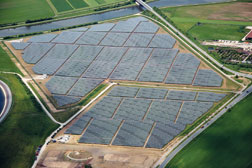|
Midcentury electricity generation will not look radically different from what we have today. Carbon-rich fossil fuels—coal, natural gas and oil—still will drive most powerplants in the U.S., but they will emit far less carbon dioxide than today’s plants, thanks to improvements in technology for capturing and storing, or sequestering, CO2. Nuclear energy, which now meets 20% of U.S. demand, will still be a major source of electricity, experts say. Outwardly, the most apparent difference will be increased use of renewable energy, promoted by government policies that will require utilities to obtain a percentage of their power from wind, solar and other inexhaustible energy sources.
“The future will have more diverse generation,” says Juan De Bedout, manager of the research and development laboratory for electric power systems at GE Global Research, Niskayuna, N.Y. The central generating station will continue to be the backbone of the electric system, but the system will be “more of a hybrid with a central powerplant and distributed energy resources,” he says.
 |
The Electric Power Research Institute, Palo Alto, Calif., is filling in the future system’s outlines with the Electricity Technology Roadmap, an evolving study of the technologies and forces that will shape the system at midcentury. A study published in December 2005 as part of the Roadmap presented scenarios for modeling the interchange of two key market drivers—changes in fuel costs and changes in societal values, particularly concern about CO2 emissions—focused on the next 20 years.
One of the principal investigators on that report says near-term change will be in legislation or regulation of the electricity industry. “We’re not running out of the primary fuels,” says Gerald Harris, senior consultant with Global Business Network, Emeryville, Calif., one of the co-authors of the EPRI-sponsored report. The oil and gas price spikes are temporary, he says.
“The industry must internalize costs that have historically been externalized,” says Harris. Industries that emit CO2 will have to account for carbon-emission costs as part of their operating costs, probably through regulatory stringency, he says, but he doesn’t foresee it happening soon. “We expect ‘stay the course’ for now because there’s a lack of political will for change.” And he’s not expecting a bailout from new technological developments. “At EPRI, no one could put their finger on a game changer,” he says. The baseload generation technologies will remain essentially as they are now for the next two decades.
| + click to enlarge |
 |
 |
The electricity industry is the largest point-source of CO2 emissions, and its dependence on coal for fuel for some 50% of its output and natural gas for about 17% more makes the industry a natural enemy of carbon constraints. But, if there ever was a united front against them, it’s cracking. At a Merrill Lynch conference last September, David Crane, president and CEO of NRG Energy Inc., Princeton, N.J., condemned the “blatant cynicism” of the power industry for favoring only voluntary greenhouse-gas restraints while planning huge new investments in coal generation. “Doing some-
thing about carbon first and foremost is a moral issue,” he told ENR. “We could be perceived like the tobacco industry.” NRG generates nearly 24,000 MW worldwide with a mixture of coal, natural gas and wind, and last summer it proposed to build two new nuclear reactors in Texas (ENR 8/7/06 p. 17).
If fossil fuels are to remain the U.S. power industry’s mainstay, and if regulations require generators to limit carbon dioxide emissions, then the technologies now in use to separate and capture CO2 must be greatly improved.
“The big issue is economics,” says Stu Dalton, EPRI director of generation. Powerplant owners are floating plans for “carbon-capture-ready” coal-fired plants, such as TXU Corp.’s program to construct 16,000 MW to 23,000 MW of new capacity (ENR 11/20/06 p. 17). But “adding CO2 capture is a non-trivial matter,” says Dalton. Capturing carbon dioxide uses energy, costs money, reduces the efficiency of the plant for generation and adds capital costs, he notes. One engineer estimates the that the installed cost of adding capture to a 500-MW powerplant is between $450 and $700 per kW, not even counting transport, sequestration, injection and operation.
Separate
At present, carbon-dioxide-capture technologies take two basic approaches, says Grant Grothen, greenhouse gas programs director at Burns & McDonnell, Kansas City. Separation obtains a pure CO2 stream from the flue-gas slipstream; utilization aims to apply the carbon dioxide in the slipstream directly as chemical input for another process, such as using it with algae to produce biofuel.
The separation technology of choice for powerplants is integrated gasification combined-cycle operation [IGCC]. It has the support of environmental advocates who accept that nothing but coal can meet baseload demand for the foreseeable future, but it remains an elusive promise. Columbus, Ohio-based American Electric Power Co.’s recent postponement of construction on its first IGCC plant because cost estimates are higher than anticipated illustrates the developing nature of the technology. Other IGCC projects are encountering similar difficulties.
“The most applicable technology at this time that could be adapted for CO2 capture on a coal-fired plant would be some sort of solvent absorber or ammonia-type scrubber,” says Robert Johnson, Burns & McDonnell greenhouse gas programs project manager. “The absorption process has been applied in the petrochemical industry.” Amine-based capture technology is the current standard.
In Pleasant Prairie, Wis., Alstom is designing and constructing an ammonia-based 5-MW pilot plant at We Energies’ 1,224-MW, 2-unit coal-powered plant. Bench-scale tests have demonstrated the potential of the ammonia process to capture more than 90% of CO2 at far lower costs than other technologies, say project officials. Nineteen other utilities are supporting the project under EPRI, which will evaluate the system performance.
“Ultimately, everything comes down to cost,” says Nancy Mohn, Alstom’s director of marketing strategies for the boiler business. Much has to be done to make gasification less costly and more reliable, she adds. “We’re at CO2 scrubbers now where we were on [sulfur dioxide] scrubbers at the start of that technology,” and SO2 scrubbers today cost far less than early projections, she notes.
Capturing carbon dixoide presents the problem faced by every dog that ever caught the car he was chasing—what to do with it. The oil and gas industry long has injected CO2 into aging production reservoirs to increase pressure and improve resource recovery, a process known as enhanced oil recovery (EOR). The Great Plains Synfuels Plant, Beulah, N.D., built in 1984 to demonstrate gasification technology, pipes carbon dioxide separated from gasified lignite to Saskatchewan for EOR. Two powerplants owned by AES Corp., Arlington, Va., capture carbon dioxide and sell it, one for freezing chickens, the other for carbonating beverages. And a number of other industrial owners similarly use CO2 in their processes.
But enhanced oil recovery requires siting the gasification near an oil field that needs enhancement. “We need options on post-combustion capture,” says EPRI’s Dalton. “There’s just so many frozen chickens and soda-pop cans.” Options could include saline aquifers, of which the U.S. has many, but operators will have to ensure that they are safe, effective and monitored and that all this can be verified and checked for leaks, he says. Researchers are seeking cost-effective ways to sequester CO2, but the overall time line in the Coal Utilization Research Council-EPRI Roadmap is more than a decade, he notes.
 Powerlight Corporation Germany encourages development of the world�s largest solar-photovoltaic generation.
|
Far better than creating CO2 that must be sequestered at great cost would be developing generation technologies that do not emit the gas. The nuclear energy industry touts its emission-free generation, and momentum is building for construction of new reactors. With subsidies encouraging photovoltaic developments, Germany in 2005 claimed pv installations totaling 837 MW, but experts say such renewables can serve only peaking loads.
Last month, the Massachusetts Institute of Technology released results of a study that found geothermal energy exploited with an “enhanced [or engineered] geothermal system” [EGS] could supply more than 100,000 MW of baseload electric capacity by 2050, 10 times the currently installed world geothermal capacity. Unlike conventional, relatively shallow hydrothermal resources called “geothermal” and limited to certain areas, EGS resources are found most everywhere, though at greater depths.
Enhanced geothermal systems mine the Earth’s heat by drilling wells 3 to 10 kilometers deep into hot rock and connecting the wells to a fractured rock region that has been stimulated to let water flow through it. The effect creates a heat exchanger that can produce large amounts of hot water or steam to run electric generators on the surface. The only fuel required would be for the drills and pumps injecting the water. And the system emits no CO2.
EGS may be promising, but experts say there’s no radically new baseload technology in development that could be on line at midcentury to dramatically reduce emissions. Barring a breakthrough development, industry will continue to develop a mix of alternative energy sources and scrubbers to meet future mandates.



Post a comment to this article
Report Abusive Comment